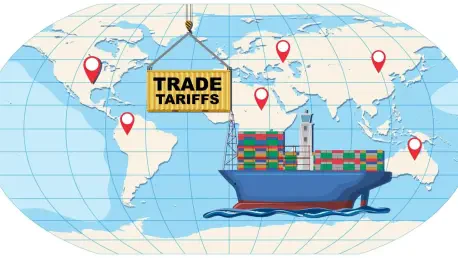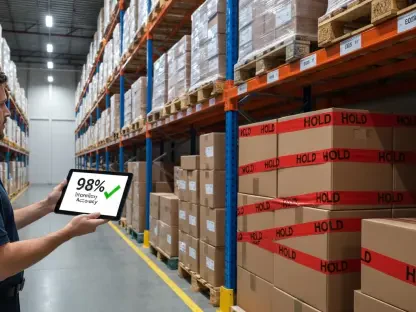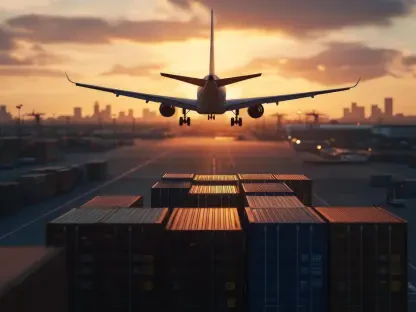In a year marked by economic turbulence, U.S. shippers and importers stand on the brink of a potentially transformative financial shift as they await a landmark Supreme Court decision on tariff refunds. With over $150 billion in tariffs, levied under the International Emergency Economic Powers Act (IEEPA) during the Trump administration, now under legal scrutiny, the stakes couldn’t be higher. A hearing scheduled for November 5 has the industry abuzz, as a ruling against these tariffs could unlock refunds of up to $108 billion, offering a lifeline to countless businesses burdened by these duties. Stemming from lower court rulings that declared the levies unlawful, this case has escalated to the nation’s highest court, promising to reshape trade dynamics. The tariffs span a wide range, targeting issues like fentanyl trafficking from Canada, Mexico, and China, alongside country-specific duties finalized in August. Yet, while the prospect of such a massive payout sparks hope, the road to securing these funds is fraught with uncertainty and complexity, leaving shippers to navigate uncharted waters with cautious anticipation.
The scale of this potential refund is staggering, often described by industry experts as unprecedented in the history of U.S. trade policy. If the Supreme Court deems the IEEPA tariffs illegal, the financial impact could reverberate across the supply chain, offering relief to importers who have grappled with these costs for years. However, the path forward is anything but straightforward, with legal and logistical barriers casting a shadow over the process. U.S. Customs and Border Protection (CBP) is expected to face an avalanche of claims, potentially overwhelming its capacity to handle requests efficiently. This looming challenge has sparked widespread discussion within the industry about how, or even if, such a large-scale refund operation can be executed without significant delays. As shippers weigh the possibility of recovering billions, the uncertainty surrounding the timeline and mechanism of distribution remains a pressing concern, prompting many to brace for a prolonged wait before any funds are returned to their accounts.
Navigating the Legal Terrain
Unpacking the Supreme Court’s Role
The upcoming Supreme Court hearing holds immense significance for shippers, as it could determine whether the IEEPA tariffs are struck down, triggering one of the largest refund initiatives in U.S. trade history. A decision in favor of importers might compel the government to return billions, directly affecting businesses of all sizes that have paid these duties on goods ranging from pharmaceuticals to industrial materials. The scope of impacted parties is vast, encompassing sectors tied to country-specific levies and broader drug trafficking measures. Yet, the outcome remains uncertain, as the court’s ruling could either provide immediate clarity or plunge the issue into further legal limbo. For now, shippers are closely monitoring developments, aware that this decision could redefine their financial obligations and alter competitive dynamics within the global trade landscape, all while reshaping how emergency economic powers are wielded in trade policy.
Even if a favorable ruling emerges, the aftermath is unlikely to bring instant resolution for those seeking refunds. Legal analysts point out that the Supreme Court might not issue a final directive on refund distribution, instead remanding the case to lower courts for additional adjudication. Such a move would extend the timeline for any financial recovery, testing the resilience of businesses already strained by tariff burdens. This potential for prolonged litigation underscores the importance of patience and strategic planning for shippers, who must prepare for various outcomes while maintaining operational stability. The hearing’s impact, therefore, extends beyond a simple verdict, as it could set precedents for how future trade disputes are resolved, influencing both policy and practice in the years ahead. Importers are left in a holding pattern, balancing hope for relief with the reality of a complex legal process that may delay tangible results.
Anticipating Procedural Roadblocks
Beyond the courtroom, the procedural challenges of securing refunds add another layer of difficulty for shippers hoping to reclaim overpaid duties. Standard refund mechanisms, such as post-summary corrections or formal protests within designated timeframes, may not apply seamlessly to IEEPA tariffs due to their unique legal basis. CBP could reject claims by asserting that these tariffs were imposed under White House directives, not agency discretion, thus deflecting responsibility for refunds. This stance creates a significant barrier, forcing importers to explore alternative avenues for recovery while grappling with the risk of outright denials. The uncertainty surrounding CBP’s role in this process has left many in the industry questioning whether traditional refund channels can accommodate such an extraordinary situation, heightening the need for innovative legal strategies to navigate this impasse.
Additionally, the sheer volume of potential refund requests poses a daunting administrative hurdle that could further complicate matters. Industry voices have warned that the influx of claims might be “100 times more than anything CBP has seen previously,” raising serious doubts about the agency’s capacity to process them efficiently. This bottleneck could lead to significant delays, leaving shippers in limbo as they await updates on their submissions. The lack of clarity on how CBP will handle this unprecedented workload only adds to the frustration, with some experts suggesting that manual processing might exacerbate timelines further. For importers, this means preparing for a drawn-out battle, not just in courtrooms but also in navigating bureaucratic red tape, as they seek to recover funds that could be critical to their financial health and long-term planning in a volatile trade environment.
Strategies for Shippers in Uncertain Times
Tackling Administrative Overload at CBP
One of the most pressing concerns for shippers is the logistical nightmare awaiting CBP if refunds are mandated by the Supreme Court. The agency, tasked with processing claims for potentially billions of dollars, faces an administrative burden of historic proportions. Experts predict that the volume of requests could overwhelm existing systems, creating delays that stretch months or even years. While some speculate that automated electronic filing systems might ease the strain, there’s no guarantee that CBP will adopt such measures or issue clear guidance promptly. This uncertainty leaves importers in a precarious position, as they must anticipate slow progress and potential errors in claim processing. The scale of this challenge highlights a critical gap in infrastructure readiness, prompting discussions within the industry about how best to support CBP in managing this unprecedented task without sacrificing accuracy or fairness in refund distribution.
Compounding the issue is the lack of historical precedent for handling refunds on this scale, which adds to the complexity of predicting outcomes. Unlike smaller, routine refund scenarios, the IEEPA tariff situation involves a diverse array of importers and a staggering financial sum, making streamlined processing a formidable task. Some industry analysts suggest that CBP might prioritize certain claims or establish temporary protocols to manage the workload, but no concrete plans have been confirmed. This ambiguity forces shippers to remain vigilant, ensuring their documentation is airtight to avoid rejection due to administrative oversights. As the potential for bottlenecks looms large, businesses must also consider the broader implications of delayed refunds on cash flow and operational planning, underscoring the need for contingency measures to weather the uncertainty surrounding CBP’s capacity to deliver timely resolutions.
Exploring Varied Paths to Refund Recovery
Amid the uncertainty, expert opinions on how shippers should prepare for potential refunds reveal a wide spectrum of strategies, reflecting the complexity of the situation. Some advisors recommend requesting liquidation extensions to delay finalization of entries, thereby preserving the opportunity to claim refunds later. Others advocate filing formal protests within the standard 180-day window post-liquidation, though there’s skepticism about CBP’s willingness to accept such claims given the unique nature of IEEPA tariffs. A more aggressive approach involves pursuing litigation in federal venues like the Court of International Trade to obtain injunctions that suspend liquidation until a final ruling is reached. This diversity of tactics illustrates the absence of a universal solution, pushing importers to tailor their approach based on financial exposure and risk tolerance while navigating a landscape rife with legal and procedural unknowns.
Another critical aspect of preparation lies in understanding the nuances of each recommended strategy and aligning them with specific business needs. For instance, companies with significant tariff payments at stake might opt for federal court action to secure stronger legal protections, while smaller importers could prioritize administrative filings to minimize costs. Legal experts also emphasize the importance of maintaining meticulous records of all relevant transactions and liquidation statuses to support claims, regardless of the chosen path. This attention to detail becomes even more vital given the potential for CBP to challenge or delay refunds on technical grounds. As shippers weigh these varied approaches, the overarching message is clear: proactive engagement with legal counsel and trade advisors is essential to navigate the maze of options and position themselves favorably for any outcome that emerges from the Supreme Court’s decision.
Building Resilience Through Proactive Measures
In the face of such ambiguity, a common thread among industry recommendations is the need for shippers to adopt a proactive stance to safeguard their interests. This begins with ensuring comprehensive documentation of all tariff payments and related entries, as any discrepancies could jeopardize refund claims. Tracking liquidation statuses closely also becomes paramount, as missing critical deadlines could forfeit recovery opportunities. Beyond paperwork, exploring multiple avenues—whether through administrative extensions, protests, or court actions—offers a layered defense against potential setbacks. This multi-pronged approach allows importers to remain flexible, adapting to new developments as they arise while mitigating the risk of being sidelined by procedural hurdles. The emphasis on readiness underscores the unpredictable nature of the refund process, urging businesses to build resilience into their strategies.
Equally important is the role of staying informed about evolving legal and administrative guidance as the Supreme Court ruling approaches. Shippers are encouraged to monitor updates from CBP and other relevant authorities, as last-minute policies or clarifications could significantly alter the refund landscape. Engaging with industry associations or legal experts can also provide valuable insights into best practices and emerging trends, helping businesses anticipate shifts in the process. This vigilance is particularly crucial given past instances where promised automatic refunds, such as those tied to Section 301 tariffs on Chinese goods, failed to materialize due to upheld legality. By fostering a culture of adaptability and continuous learning, importers can better position themselves to tackle the challenges ahead, ensuring they are not caught off guard by the complexities of securing what could be a historic financial recovery.









